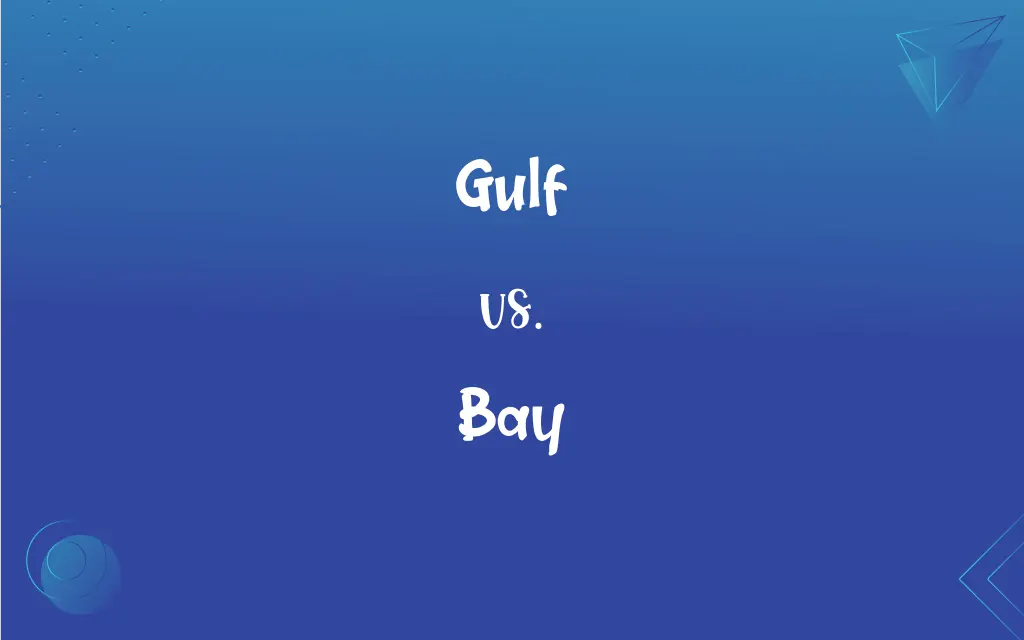Gulf vs. Bay: What's the Difference?
Edited by Aimie Carlson || By Harlon Moss || Updated on October 20, 2023
A gulf is a large body of saltwater partly enclosed by land, while a bay is a waterbody enclosed by land on three sides, often smaller than a gulf.

Key Differences
A gulf is a large portion of the ocean that penetrates land, generally characterized by its considerable size and depth. A bay, in comparison, is a body of water partly enclosed by land but can vary greatly in size and is typically less extensive than a gulf.
The term "gulf" typically implies a broader and deeper indentation, sometimes covering vast expanses. On the other hand, a bay can be modest or expansive but is often shallower and narrower than a gulf. Both bays and gulfs are coastal features that are bordered, at least partially, by land.
One of the prominent features of a gulf is that it's often connected to the ocean or sea by a narrower mouth. A bay, however, may have a broader or narrow mouth, with its shape typically determined by the surrounding landform. Both gulfs and bays provide natural harbors and have historically been vital for trade and exploration.
Oftentimes, the distinction between a gulf and a bay isn't just based on size or depth but on historical and regional naming conventions. For instance, the Gulf of Mexico is vast, while the Bay of Bengal is also vast but termed a bay. Both gulfs and bays play essential roles in local ecosystems, influencing weather patterns and serving as habitats for diverse marine life.
Comparison Chart
Size & Depth
Typically larger and deeper.
Varies in size, generally shallower than gulfs.
ADVERTISEMENT
Shape
Wider indentation, narrower mouth connection.
Can have wide or narrow mouth, shape varies.
Historical Naming
Some large water bodies named gulfs due to tradition.
Naming often due to regional or historical conventions.
Function
Often significant for global navigation and trade.
Provides natural harbors, essential for local trade.
Geographical Reach
Might stretch further into the landmass.
Usually doesn't penetrate as deeply into land.
Gulf and Bay Definitions
Gulf
A large portion of the ocean surrounded by land.
The Gulf of Mexico is one of the largest gulfs in the world.
ADVERTISEMENT
Bay
A color in horses, characterized by a reddish-brown body.
The bay mare stood out in the herd.
Gulf
A significant disparity or division.
There's a considerable gulf between their political beliefs.
Bay
A compartment in an aircraft or vehicle.
The bay of the aircraft held the cargo.
Gulf
A deep inlet of the sea.
The region surrounding the gulf boasts a rich marine ecosystem.
Bay
A recessed area of land.
The bay window provided a perfect reading nook.
Gulf
A chasm or abyss.
The hiker almost fell into a deep gulf in the mountains.
Bay
A body of water partly enclosed by land.
We anchored the boat in a secluded bay.
Gulf
A broad difference in character or attitude.
The gulf between the rich and the poor continues to widen.
Bay
The sound dogs make while chasing.
The bay of the hounds echoed through the forest.
Gulf
Abbr. G. A large area of a sea or ocean partially enclosed by land, especially a long landlocked portion of sea opening through a strait.
Bay
A body of water partially enclosed by land but with a wide mouth, affording access to the sea
The Bay of Biscay.
FAQs
Can a bay be as large as a gulf?
While gulfs are typically larger, some bays like the Bay of Bengal are vast due to historical naming conventions.
How does a bay differ from a gulf?
A bay is a waterbody enclosed by land on three sides, generally smaller and shallower than a gulf.
Do both bays and gulfs offer natural harbors?
Yes, both can provide natural harbors, although bays are frequently sought after for their protective features.
Which is typically deeper, a gulf or a bay?
Gulfs are generally deeper than bays.
Are gulfs always connected to larger water bodies?
Yes, gulfs are typically connected to seas or oceans.
How do gulfs influence local climates?
The presence of a gulf can moderate temperatures and increase humidity in adjacent land areas.
Can a gulf have islands within it?
Yes, many gulfs have islands within their boundaries.
Why is the naming of bays and gulfs sometimes inconsistent with their sizes?
Regional and historical naming conventions play a role, rather than just size or depth.
Is a bay the same as a cove?
No, a cove is a smaller type of bay with a narrow entrance.
Do bays have ecological significance?
Yes, bays often have diverse marine ecosystems and serve as breeding grounds for various marine species.
What is a gulf?
A gulf is a large portion of the ocean partly enclosed by land, often deeper and more extensive than a bay.
Is the Gulf of Mexico larger than the Bay of Bengal?
No, the Bay of Bengal is larger in terms of area, but it's termed a bay due to historical conventions.
Can a bay be freshwater?
While bays are usually saltwater, they can be freshwater when connected to large freshwater bodies like lakes.
Do bays play a role in local economies?
Absolutely, many bays have ports and support fishing, tourism, and other industries.
Why are gulfs significant in navigation?
Gulfs often provide crucial passageways and harbors for global maritime trade.
How are bays formed geographically?
Bays can be formed by various processes, including erosion, tectonic activity, and glaciation.
Which offers better protection during storms, a bay or a gulf?
Bays, due to their enclosure, often provide better shelter from storms.
Are there famous bays known for their beauty?
Yes, places like the San Francisco Bay and the Bay of Kotor are renowned for their scenic beauty.
Which has a broader opening to the sea, a gulf or a bay?
This varies, but gulfs often have narrower mouths compared to their overall size, whereas bays might have wider openings.
How does human activity impact gulfs?
Pollution, overfishing, and coastal development can significantly affect gulf ecosystems.
About Author
Written by
Harlon MossHarlon is a seasoned quality moderator and accomplished content writer for Difference Wiki. An alumnus of the prestigious University of California, he earned his degree in Computer Science. Leveraging his academic background, Harlon brings a meticulous and informed perspective to his work, ensuring content accuracy and excellence.
Edited by
Aimie CarlsonAimie Carlson, holding a master's degree in English literature, is a fervent English language enthusiast. She lends her writing talents to Difference Wiki, a prominent website that specializes in comparisons, offering readers insightful analyses that both captivate and inform.































































